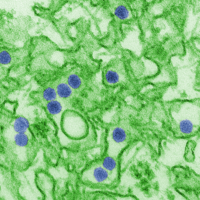
Photo from wikipedia
The SARS-CoV-2 virus, the agent of COVID-19, caused unprecedented loss of lives and economic decline worldwide. Although the introduction of public health measures, vaccines, diagnostics, and therapeutics disrupted the spread… Click to show full abstract
The SARS-CoV-2 virus, the agent of COVID-19, caused unprecedented loss of lives and economic decline worldwide. Although the introduction of public health measures, vaccines, diagnostics, and therapeutics disrupted the spread of the SARS-CoV-2, the emergence of variants poses substantial threat. This study traced SARS-CoV-2 variants circulating in Uganda by July 2021 to inform the necessity for refinement of the intervention medical products. A comprehensive in silico analysis of the SARS-CoV-2 genomes detected in clinical samples collected from COVID-19 patients in Uganda revealed occurrence of structural protein variants with potential of escaping detection, resisting antibody therapy, or increased infectivity. The genome sequence dataset was retrieved from the GISAID database and the open reading frame encoding the spike, envelope, membrane, or nucleocapsid proteins was translated. The obtained protein sequences were aligned and inspected for existence of variants. The variant positions on each of the four alignment sets were mapped on predicted epitopes as well as the 3D structures. Additionally, sequences within each of the sets were clustered by family. A phylogenetic tree was constructed to assess relationship between the encountered spike protein sequences and Wuhan-Hu-1 wild-type, or the Alpha, Beta, Delta and Gamma variants of concern. Strikingly, the frequency of each of the spike protein point mutations F157L/Del, D614G and P681H/R was over 50%. The furin and the transmembrane serine protease 2 cleavage sites were unaffected by mutation. Whereas the Delta dominated the spike sequences (16.5%, 91/550), Gamma was not detected. The envelope protein was the most conserved with 96.3% (525/545) sequences being wild-type followed by membrane at 68.4% (397/580). Although the nucleocapsid protein sequences varied, the variant residue positions were less concentrated at the RNA binding domains. The dominant nucleocapsid sequence variant was S202N (34.5%, 205/595). These findings offer baseline information required for refining the existing COVID-19 vaccines, diagnostics, and therapeutics.
Journal Title: PLOS ONE
Year Published: 2022
Link to full text (if available)
Share on Social Media: Sign Up to like & get
recommendations!